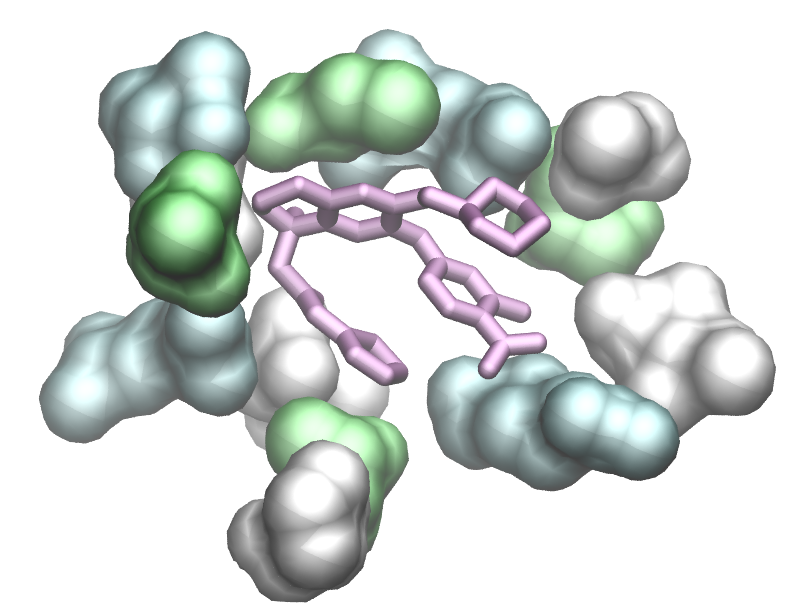D-Wave's computers are especially good at solving optimization problems.

While many companies are now offering access to general-purpose quantum computers, they're not currently being used to solve any real-world problems, as they're held back by issues with qubit count and quality. Most of their users are either running research projects or simply gaining experience with programming on the systems in the expectation that a future computer will be useful.
There are quantum systems based on superconducting hardware that are being used commercially; it's just that they're not general-purpose computers.
D-Wave offers what's called a quantum annealer. The hardware is a large collection of linked superconducting devices that use quantum effects to reach energetic ground states for the system. When properly configured, this end state represents the solution to a mathematical problem. Annealers can't solve the same full range of mathematical problems as general-purpose quantum computers, such as the ones made by Google, IBM, and others. But they can be used to solve a variety of optimization problems.
While the systems can suffer from errors, the consequences are relatively minor, as they tend to leave the systems with a solution that is mathematically close to an optimal one.
Unlike with general-purpose quantum computers, it hasn't been mathematically demonstrated that quantum annealers can consistently outperform traditional computers. But unlike general-purpose quantum computers, they have for several years had a high numbers of bits, good connectivity, and reasonable error rates. And a number of companies are now using them to solve real-world problems.
Drug searches
One of the companies that relies on D-Wave's hardware is POLARISqb, which works in the field of drug discovery, identifying potential drug molecules in software for companies to test them in biological systems. Its general approach is widespread in the pharmaceutical industry: identify a disease caused by inappropriate activity of a protein, then find a molecule that alters the protein's function in a way that relieves the disease.
If you know the three-dimensional structure of the protein and which parts of the protein are needed for its functions, you can use computer modeling to see how well drug molecules latch on to that part. That sort of modeling is computationally expensive, but it's still cheaper than synthesizing the molecule and testing it on cells. It's also part of POLARISqb's process—but it comes after using a quantum annealer, which is used to identify molecules to test with detailed modeling.
"We design a virtual large chemical space, and we use a quantum computer to search that chemical space to find the best molecules," POLARISqb founder Shahar Keinan told Ars. The concept of "best" here goes well beyond molecules simply latching onto a protein well.
"We're not just looking for molecules that have a single property; we're looking for molecules that will have a whole profile of properties that will give us what we're looking for," Keinan said. "The molecule cannot be too big or too small; the molecule has to be soluble enough, but not too soluble. The molecule has to have certain properties, like a number of hydrogen bond donors and acceptors." It also has to be something that can be synthesized relatively easily.

Given all these constraints, there will likely not be one single molecule that fulfills them all; instead, research will get one or more populations of related molecules that are relatively good fits for most applications. Identifying these potential drugs from a sea of molecules is an optimization problem—one that gets more computationally intense as you expand the size of the sea. And optimization problems are precisely the sort of thing that D-Wave's computers are designed to handle.
POLARISqb started off working with Fujitsu, which offers customized hardware that can simulate quantum annealing using traditional silicon chips. But when the team moved to D-Wave, it used the opportunity to rethink how it organizes its work. "It makes sense to design the library in a way that will fit that architecture so that things that are close in the internal architecture of D-Wave are also close in the internal architecture of the library itself," Keinan said. That's partly because when errors occur in the D-Wave hardware, the output is often very close to the intended result, so it would point to a closely related molecule.
"We're not expecting it to give us the same answer every time," Keinan told Ars. "We run it several times to find different pockets of activity, if you will. We think of those as attractors—areas of chemical space where you have a concentration of molecules that are good."
When the team at POLARISqb started, the D-Wave hardware couldn't fit the libraries of chemicals the company wanted to check. So the team relied on D-Wave's developer platform, which helped break up the library into smaller chunks that could be evaluated separately, with the results combined on classical computers. Since then, a newer generation of processors has allowed for evaluating libraries containing billions of molecules.

Keinan said the transition to a quantum annealer wasn't necessarily easy. The team had to "translate chemistry and biology" into commands on unfamiliar computer architecture. And it had to figure out how to value different goals, like solubility and protein interactions, that may be partly incompatible. But like most software development projects, the team started with small chemical libraries to show that the code worked and then scaled up to the billions. "We are a 2-year-old company, and we're still improving our code," Keinan said.
The analysis run on the D-Wave hardware is integrated into a pipeline that includes the more detailed modeling of protein-drug interactions done on classical computers. In effect, it screens a library of billions of molecules and identifies a few tens of thousands that are worth performing the detailed analysis on.
Keinan doesn't doubt that the same thing could be done on classical computer hardware. Her company just estimates that it would be more expensive. "We've done some calculation to see what's the time difference, and our brute force on distributed Google Cloud will take us two orders of magnitude, maybe sometimes three orders of magnitude longer than to run it on a quantum computer," she told Ars. "This is OK if you have a billion molecules; when you reach 2 billion molecules, you are really beginning to pay, and when you reach 10 billion molecules, that's something that is going to be completely not cost-effective."
"This year, we're going to do 20 projects," she said. "We have customers—paying customers—which is unique for some of the quantum computing companies."
The cargo must flow
Identifying drugs may seem like the sort of thing that quantum computers should be good at. But the sorts of optimization problems that it represents also show up in many more down-to-earth contexts. We talked to people from a company called SavantX, which used a D-Wave machine to help keep goods flowing smoothly through a port facility.
Peter Lindeback, who served as the director of strategic initiatives for the company that owned the port, described the challenges of managing the facility, located in Los Angeles. Combined with the neighboring Port of Long Beach, the San Pedro Bay port complex forms the largest shipping complex in the Western Hemisphere, and the facility Lindeback's company was responsible for was one of the largest ones there, covering 300 acres and handling well over 1.2 million containers per year. Each of those containers had to be lifted off a ship, placed on the ground, and then placed on a truck that took it out of the facility.
That container choreography creates a challenging optimization problem. Lindeback said that any time the cranes spend waiting for a truck is lost productivity. Any time the cranes spend moving to where a truck is waiting increases fuel use, carbon emissions, and maintenance costs. So the optimization involves making sure that trucks flow through the facility in a way that sends them to pick up containers as close as possible to where a crane is already located. "The distance traveled is not only important for time but also for maintenance," SavantX's David Ostby told Ars. "Because if you cut the number of miles that you drive a crane in half every day, you're also cutting your likelihood of a failure."

When SavantX was brought on, the trucks were organized using a cloud-based classical algorithm, which gets answers quickly enough to keep the system working in real time but isn't likely to find a highly optimized solution once problems start to become complex. While it might be possible to code a more effective algorithm on a traditional computer, SavantX decided to try using D-Wave's hardware. "It's not like we probably couldn't develop a classical algorithm that would compete with the quantum algorithm," Ostby said. "But it may not get done in time, [and] it would be kind of expensive to write."
Several factors went into this decision. One was the value of getting experience developing the hardware. And because of the way quantum annealers work, one is more or less guaranteed to produce a usable answer quickly—or fail with enough time to fall back to the existing algorithm. And even when errors occur, the D-Wave machine produces an answer that is likely to be very close to an optimal solution.
Rather than use the software development environment provided by D-Wave, SavantX hired physicists and people who had experience with D-Wave's machine and coded its own solution by controlling the hardware directly. According to Ostby, the algorithm is immune to errors when a small number of trucks are waiting for cranes, and there is limited impact as that number rises. It was originally coded for an earlier generation of D-Wave hardware and still doesn't need all the features of the current machines, such as a higher qubit count.
That control software is embedded in a larger classical control program, which organizes input to be sent to the D-Wave hardware, gets the results, and uses them to create a set of priorities that are then communicated to other systems and converted to something humans can act on.
The process of rolling the software out was fairly simple. "You make a copy of the port, and then you run the test against what's really happening, and then you look at the results. And you keep doing that until you're happy," Ostby told Ars. "Then you push the button and make it go. And then you go on vacation, right?"
Pushing the button produced some obvious benefits. The D-Wave and classical algorithms were roughly equal, with one or two trucks waiting for slots. But as the numbers climbed, the solutions provided by D-Wave hardware developed an edge that expanded dramatically by the time the truck queue hit the double digits. SavantX has published numbers that indicate that each crane did twice as many deliveries each day while dropping the distance traveled by a third. Cranes were typically productive less than half a day before the switch and cleared 70 percent afterward.
Not general, but useful?
As seen in the very different applications developed by these two companies, optimization problems show up in a huge range of useful applications. And it's clear that D-Wave's quantum system can provide solutions to them. For these specific problems, it's not clear whether an algorithm could be developed on typical computing hardware that could beat the quantum annealer. But even if one could, some companies have found that the annealers provide a compelling solution for the specific problems they face.



Recommended Comments
There are no comments to display.
Join the conversation
You can post now and register later. If you have an account, sign in now to post with your account.
Note: Your post will require moderator approval before it will be visible.